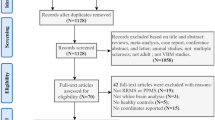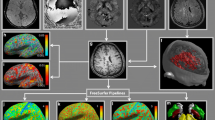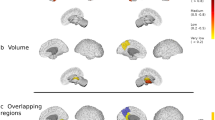Abstract
Disability in multiple sclerosis (MS) patients is associated with white matter (WM) and gray matter (GM) pathology, and both processes contribute differently over the disease course. Total and regional GM volume loss can be imaged via voxel-based morphometry (VBM). Here, we retrospectively analyzed a group of 213 MS patients [163 relapsing remitting (RR) and 50 secondary progressive (SP)] using semi-automated white matter (WM) lesion mapping and voxel-based morphometry (VBM). Our aim was to assess the association of increasing disability with decreasing total and regional GM volume. As expected, total GM volume and WM lesion load were associated with patients disability, measured with the Expanded Disability Status Scale (EDSS). The more impaired the patients, the greater the statistical association to the total GM volume. Regional volume loss in the cerebellar gray matter was associated with increasing EDSS and WM lesion volume. Furthermore, SPMS patients had significantly more gray matter volume loss in the cerebellum and the hippocampus compared to RRMS patients. Our results confirm histopathological studies emphasizing the important role of the cerebellum and the hippocampus in MS patients’ disability.




Similar content being viewed by others
References
Dutta R, Trapp BD (2011) Mechanisms of neuronal dysfunction and degeneration in multiple sclerosis. Prog Neurobiol 93:1–12
Compston A, Coles A (2008) Multiple sclerosis. Lancet 372:1502–1517
Tedeschi G, Lavorgna L, Russo P et al (2005) Brain atrophy and lesion load in a large population of patients with multiple sclerosis. Neurology 65:280–285
Vercellino M, Plano F, Votta B et al (2005) Grey matter pathology in multiple sclerosis. J Neuropathol Exp Neurol 64(12):1101–1107
Roosendaal SD, Bendfeldt K, Vrenken H et al (2011) Grey matter volume in a large cohort of MS patients: relation to MRI parameters and disability. Mult Scler 17:1098–1106
Kurtzke JF (1983) Rating neurologic impairment in multiple sclerosis: an expanded disability status scale (EDSS). Neurology 33:1444–1452
Fisniku LK, Brex PA, Altmann DR et al (2008) Disability and T2 MRI lesions: a 20-year follow-up of patients with relapse onset of multiple sclerosis. Brain 131:808–817
Prinster A, Quarantelli M, Lanzillo R et al (2010) A voxel-based morphometry study of disease severity correlates in relapsing remitting multiple sclerosis. Mult Scler 16:45–54
Bakshi R, Benedict RH, Bermel RA et al (2001) Regional brain atrophy is associated with physical disability in multiple sclerosis: semiquantitative magnetic resonance imaging and relationship to clinical findings. J Neuroimaging 11:129–136
Fisniku LK, Chard DT, Jackson JS et al (2008) Gray matter atrophy is related to long-term disability in multiple sclerosis. Ann Neurol 64:247–254
Gilmore CP, Donaldson I, Bo L et al (2009) Regional variations in the extent and pattern of grey matter demyelination in multiple sclerosis: a comparison between the cerebral cortex, cerebellar cortex, deep grey matter nuclei and the spinal cord. J Neurol Neurosurg Psychiatry 80:182–187
Geurts JJ, Bo L, Roosendaal SD et al (2007) Extensive hippocampal demyelination in multiple sclerosis. J Neuropathol Exp Neurol 66:819–827
Ashburner J, Friston KJ (2000) Voxel-based morphometry–the methods. Neuroimage 11:805–821
Riccitelli G, Rocca MA, Pagani E et al (2012) Mapping regional grey and white matter atrophy in relapsing-remitting multiple sclerosis. Mult Scler 18:1027–1037
Polman CH, Reingold SC, Banwell B et al (2011) Diagnostic criteria for multiple sclerosis: 2010 revisions to the McDonald criteria. Ann Neurol 69:292–302
Ceccarelli A, Jackson JS, Tauhid S et al (2012) The impact of lesion in-painting and registration methods on voxel-based morphometry in detecting regional cerebral gray matter atrophy in multiple sclerosis. AJNR Am J Neuroradiol 33:1579–1585
Schmidt P, Gaser C, Arsic M et al (2012) An automated tool for detection of FLAIR-hyperintense white-matter lesions in multiple sclerosis. Neuroimage 59:3774–3783
Ashburner J (2007) A fast diffeomorphic image registration algorithm. Neuroimage 38:95–113
Mechelli A, Friston KJ, Frackowiak RS et al (2005) Structural covariance in the human cortex. J Neurosci 25:8303–8310
Lavorgna L, Bonavita S, Ippolito D et al (2014) Clinical and magnetic resonance imaging predictors of disease progression in multiple sclerosis: a nine-year follow-up study. Mult Scler 20:220–226
Pulizzi A, Rovaris M, Judica E et al (2007) Determinants of disability in multiple sclerosis at various disease stages: a multiparametric magnetic resonance study. Arch Neurol 64:1163–1168
Ge Y, Grossman RI, Udupa JK et al (2000) Brain atrophy in relapsing-remitting multiple sclerosis and secondary progressive multiple sclerosis: longitudinal quantitative analysis. Radiology 214:665–670
Kutzelnigg A, Lassmann H (2005) Cortical lesions and brain atrophy in MS. J Neurol Sci 233:55–59
Reynolds R, Roncaroli F, Nicholas R et al (2011) The neuropathological basis of clinical progression in multiple sclerosis. Acta Neuropathol 122:155–170
Steenwijk MD, Daams M, Pouwels PJ et al (2014) What explains gray matter atrophy in long-standing multiple sclerosis? Radiology 272:832–842
Bendfeldt K, Kuster P, Traud S et al (2009) Association of regional gray matter volume loss and progression of white matter lesions in multiple sclerosis—a longitudinal voxel-based morphometry study. Neuroimage 45:60–67
Kutzelnigg A, Faber-Rod JC, Bauer J et al (2007) Widespread demyelination in the cerebellar cortex in multiple sclerosis. Brain Pathol 17:38–44
Weier K, Banwell B, Cerasa A et al (2015) The role of the cerebellum in multiple sclerosis. Cerebellum 14:364–374
Henry RG, Shieh M, Okuda DT et al (2008) Regional grey matter atrophy in clinically isolated syndromes at presentation. J Neurol Neurosurg Psychiatry 79:1236–1244
Anderson VM, Fisniku LK, Altmann DR et al (2009) MRI measures show significant cerebellar gray matter volume loss in multiple sclerosis and are associated with cerebellar dysfunction. Mult Scler 15:811–817
Weier K, Penner IK, Magon S et al (2014) Cerebellar abnormalities contribute to disability including cognitive impairment in multiple sclerosis. PLoS One 9:e86916
Papadopoulos D, Dukes S, Patel R et al (2009) Substantial archaeocortical atrophy and neuronal loss in multiple sclerosis. Brain Pathol 19:238–253
Sicotte NL, Kern KC, Giesser BS et al (2008) Regional hippocampal atrophy in multiple sclerosis. Brain 131:1134–1141
Sacco R, Bisecco A, Corbo D et al (2015) Cognitive impairment and memory disorders in relapsing-remitting multiple sclerosis: the role of white matter, gray matter and hippocampus. J Neurol 262:1691–1697
Chiaravalloti ND, DeLuca J (2008) Cognitive impairment in multiple sclerosis. Lancet Neurol 7:1139–1151
Author information
Authors and Affiliations
Corresponding author
Ethics declarations
Conflicts of interest
M. Grothe has received travel reimbursement from Novartis Pharma, Teva and BiogenIdec and research Grants from the Federal Ministry for Research and Education in Germany. M. Lotze has received research Grants from the German Research Foundation and the Federal Ministry for Research and Education in Germany. S. Langner received institutional support from the University of Greifswald for investigator initiated studies. A. Dressel has received research Grants, speaker and consulting honoraria as well as travel reimbursement from Novartis Pharma, Bayer Schering, Teva, Sanofi Aventis, Genzyme, Merck Serono and BiogenIdec.
Ethical standard statement
The study was approved by the Local Ethical Committees and written informed consent from each subject was obtained prior to their enrolment.
Rights and permissions
About this article
Cite this article
Grothe, M., Lotze, M., Langner, S. et al. The role of global and regional gray matter volume decrease in multiple sclerosis. J Neurol 263, 1137–1145 (2016). https://doi.org/10.1007/s00415-016-8114-3
Received:
Revised:
Accepted:
Published:
Issue Date:
DOI: https://doi.org/10.1007/s00415-016-8114-3




